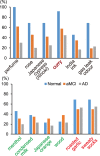Heterogeneity of odorant identification impairment in patients with Alzheimer's Disease
- PMID: 28684764
- PMCID: PMC5500500
- DOI: 10.1038/s41598-017-05201-7
Heterogeneity of odorant identification impairment in patients with Alzheimer's Disease
Abstract
Alzheimer's disease (AD) patients exhibit olfactory dysfunction. However, the olfactory declineti precise nature is not fully understood. One hundred patients (60 AD, 28 amnestic mild cognitive impairment (aMCI), 12 Normal) were enrolled. All participants underwent olfactory function testing using an odour stick identification test for Japanese (OSIT-J). OSIT-J scores were significantly correlated with recall. We classified OSIT-J odorants into three groups: Category I, odorants that were difficult for normal aged subjects to identify; Category II, odorants that became harder to accurately identify with cognitive decline; and Category III, odorants that even AD patients could identify. We defined a "cognitive subset" consisting of six Category II OSIT-J odorants (perfume, rose, Japanese cypress, curry, India ink and gas leak odour). The ability to identify "cognitive subset" odours was significantly better indicator of cognitive status than the ability to identify "non-cognitive subset", which consisted of the six remaining items. The ability to identify the gas leak odorant was decreased early in the aMCI stage, suggesting a need to reconsider the odours used to signal gas leaks. The "cognitive subset" would provide a more convenient and effective biomarker for diagnosing dementia in clinical settings.
Conflict of interest statement
The authors declare that they have no competing interests.
Figures




References
-
- Ward, A. M., Calamia, M., Thiemann, E., Dunlap, J. & Tranel, D. Association between olfaction and higher cortical functions in Alzheimer’s disease, mild cognitive impairment, and healthy older adults. J Clin Exp Neuropsychol 1–15, doi:10.1080/13803395.2016.1253667 (2016). - PubMed
Publication types
MeSH terms
Substances
LinkOut - more resources
Full Text Sources
Other Literature Sources
Medical

